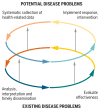Driving improvements in emerging disease surveillance through locally relevant capacity strengthening
- PMID: 28706036
- PMCID: PMC7612379
- DOI: 10.1126/science.aam8332
Driving improvements in emerging disease surveillance through locally relevant capacity strengthening
Abstract
Emerging infectious diseases (EIDs) threaten the health of people, animals, and crops globally, but our ability to predict their occurrence is limited. Current public health capacity and ability to detect and respond to EIDs is typically weakest in low- and middle-income countries (LMICs). Many known drivers of EID emergence also converge in LMICs. Strengthening capacity for surveillance of diseases of relevance to local populations can provide a mechanism for building the cross-cutting and flexible capacities needed to tackle both the burden of existing diseases and EID threats. A focus on locally relevant diseases in LMICs and the economic, social, and cultural contexts of surveillance can help address existing inequalities in health systems, improve the capacity to detect and contain EIDs, and contribute to broader global goals for development.
Copyright © 2017, American Association for the Advancement of Science.
Figures



References
Publication types
MeSH terms
Grants and funding
- BB/L018845/1/BB_/Biotechnology and Biological Sciences Research Council/United Kingdom
- BB/J010367/1/BB_/Biotechnology and Biological Sciences Research Council/United Kingdom
- BB/L018926/1/BB_/Biotechnology and Biological Sciences Research Council/United Kingdom
- 095787/WT_/Wellcome Trust/United Kingdom
- 207569/Z/17/Z/WT_/Wellcome Trust/United Kingdom
LinkOut - more resources
Full Text Sources
Other Literature Sources

